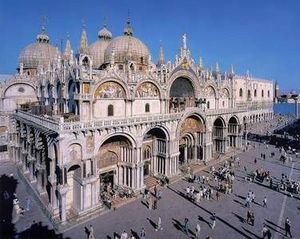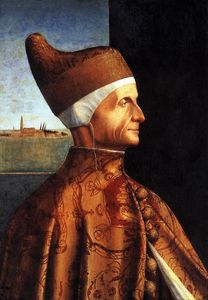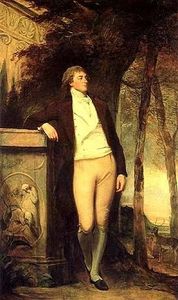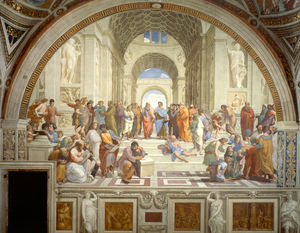Doge Leonardo Loredan
- Date of Creation:
- 1501
- Alternative Names:
- Leonardo Loredan
- Height (cm):
- 61.60
- Length (cm):
- 45.10
- Medium:
- Oil
- Support:
- Wood
- Subject:
- Figure
- Technique:
- impasto
- Web Page:
- http://www.nationalgallery.org.uk/paintings/giovanni-bellini-doge-leonardo-loredan
- Art Movement:
- Renaissance
- Created by:
- Current Location:
- London, United Kingdom
- Displayed at:
- National Gallery London
- Owner:
- National Gallery London
Doge Leonardo Loredan Story / Theme
During its one thousand years in existence, the Most Serene Republic of Venice was ruled by chief magistrates called Doges, who were elected by the aristocracy and ruled for life. Bellini was commissioned to paint this portrait shortly after Loredan was elected Doge and the artist was following in the footsteps of his brother and other illustrious painters who had also depicted doges.
For a number of years, Venetian tradition dictated that rulers would have their portraits painted while wearing state robes and in a style that mimicked Roman bust sculptures. Today, visitors to the Sala del Collegio in the Palacio Ducal (Doge's Palace) in Venice can see portraits of all of the 120 Doges except for one, who was executed for attempting to stage of coup d'état.
The Doges were painted while wearing the robes they would wear to formal state affairs, complete with the corno or decorative hat shaped like a worn-down horn.
Doge Leonardo Loredan Inspirations for the Work
Commission:
The Doge himself commissioned Bellini to paint this piece, presumably because Bellini's extensive work in the Doge's Palace had been so well-received. Portraits such as these had become customary when a new Doge assumed power in Venice.
Unlike most Italian portraits of the Middle Ages - which were painted in profile - Bellini welcomed the Renaissance transition to painting portraits head-on or at a slight angle. Previously, face-front portraits were reserved for holy figures, while mortals would be painted in profile to signify their spiritual incompleteness.
This shift indicates the budding Renaissance mentality that men were not relegated to a life of spiritual destitution, but could seek to understand their world and God better should they choose to do so.
Northern European Art:
Bellini drew a great amount of inspiration for this and other, later works from the great Northern European artists who were the first to create full paintings in oil. Their attention to detail and light are apparent in Bellini's treatment of the Doge's expression and garments.
Tuscan Art:
Tuscan artists experimented with spatial illusions in painting more than most other artists, and Bellini took to this technique readily. Unlike the relatively flat portrait of the previous Doge (painting, incidentally, by Gentile Bellini), Bellini's portrait of Leonardo Loredan exists in a naturalistic, almost casual three-dimensionality.
Doge Leonardo Loredan Analysis
Portraits are meant to capture the sitter's station in life, but later also attempted to encapsulate their personalities.
Textures and patterns:
One of the most remarkable aspects of the portrait of Doge Leonardo Loredan is the sensuous manner with which Bellini rendered the fabric of the his formal robes. Truly a reflection of the Venetian style, the silver and gold brocade Bellini painted without sparing a single detail appeals not only to the viewer's sense of sight - it is beautiful and ornate - but to his or her sense of touch as well.
Techniques:
Bellini achieved this realistic texture in part by employing the technique of impasto, in which paint is layered on thickly to create raised sections. When accomplished by a skilled artist, these raised areas help diffuse light in exactly the intended way, working in conjunction with the colors to achieve the effect.
Mood, tone and emotion:
Portraits, especially those of men, had been meant to capture the sitter's position in life - usually these were people with a considerable amount of money who could afford to pay an artist. During the Renaissance, portraits retained this function but their painters began to attempt to encapsulate a bit of the sitter's inner self - either the type of feelings the sitter desired to elicit in others or the artist's projection of the sitter's inner self.
The inner self of Doge Loredan that Bellini and the Doge himself were trying to portray is one that is wise and unyielding - what critics have often referred to as a "steely gaze."
Color palette and use of light:
As with nearly all of Bellini's paintings, Doge Leonardo Loredan is a splendid example of Bellini's light-manipulating skill. With the impasto painting technique to bolster his already strong command of light-painting, Bellini was able to render the Doge's garments as remarkably realistic.
Doge Leonardo Loredan Critical Reception
Bellini's portrait of Doge Leonardo Loredan has frequently been lauded as the pinnacle of Venetian portraiture - encapsulating the sensuousness, opulence and pride of the Venetian Republic.
During life:
While Bellini was alive, this portrait would have hung in the Doge's Palace where those visiting on matters of state would have been able to appreciate its immense intricacies. According to painter Giorgio Vasari, who was born a decade after the portrait was completed, Bellini's painting of Doge Leonardo Loredan in particular "met with great praise" by Bellini's contemporaries.
After death:
Praise for Doge Leonardo Loredan has not ceased in the centuries following Bellini's death. This work has been elevated to a high status as one of the finest specimens of Venetian art. Bellini's portrait of the Doge has been called one of two supreme examples of Doge portraiture - the other being Titian's portrait of Doge Andrea Gritti. Later scholars also commend Bellini's portrayal of the Doge as 'individual' with regards to hints of emotion and detail, and a piece that established a new style of portraiture.
Doge Leonardo Loredan Related Paintings
Doge Leonardo Loredan Locations Through Time - Notable Sales
During the last twenty years of Leonardo Loredan's life, his portrait would have been on display in the Doge's Palace, where he lived in Venice. Presumably, the portrait remained intact in the Doge's Palace until Napoleon conquered the Venetian Republic in 1797 and claimed many of the Serenissima's prized paintings and sculptures. He may have taken the Doge back to Paris but that is unlikely as the next owner, Thomas Beckford, did not visit Paris during the ensuing years.
William Thomas Beckford, an English novelist and art collector, purchased Doge Leonardo Loredan in 1807 for 13 guineas, which would be about £853.00 today. He then sold it to the National Gallery in 1844 for £630, which would be roughly £51,000.00 today.
Beckford also owned a few other Bellini paintings, including Giovanni's Agony in the Garden and Gentile's portrait of Doge Giovanni Mocenigo.
Doge Leonardo Loredan Artist
Giovanni Bellini was born into a prominent family of painters and lived in Venice his entire life. Famous for his delicate handling of light and life-like images, Bellini made a distinct name for himself during his lengthy career, receiving countless commissions to paint religious scenes and portraits.
He painted Doge Leonardo Loredan fifteen years before his death, when his expertise had effectively transcended that of all other Venetian artists.
Doge Leonardo Loredan Art Period
Bellini was an artist of the Italian Renaissance and was instrumental in creating the transition from Early Renaissance to High Renaissance in Venice. His father, in fact, is credited with solidifying the Renaissance's place in Venetian art. Doge Leonardo Loredan was painted during the High Renaissance.
Doge Leonardo Loredan Bibliography
To find out more about Bellini and his paintings please select from the following recommended sources.
• Aikema, Bernard & Brown, Beverly Louise. Renaissance Venice and the North: Crosscurrents in the Time of Dürer, Bellini and Titian: Thames & Hudson, 2000
• Batschmann, Oskar. Giovanni Bellini. Reaktion Books, 2008
• Christiansen, Keith & Weppelmann, Stefan. The Portrait in Renaissance Italy: From Donatello to Bellini. Metropolitan Museum of Art, 2011
• Fry, Roger Eliot. Giovanni Bellini. BiblioBazaar, 2008
• Lowry, Elizabeth. The Bellini Madonna. Quercus Publishing Plc, 2009
• Tempestini, Anchise. Giovanni Bellini. Abbeville Press Inc. , 1999














